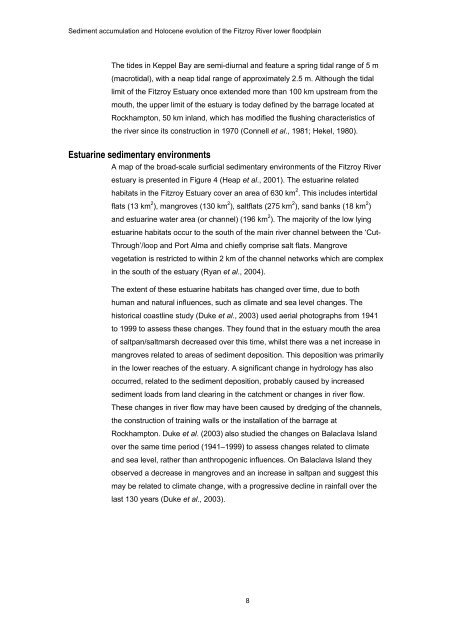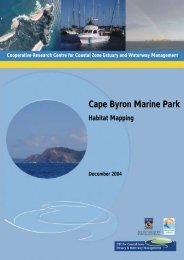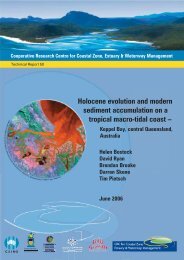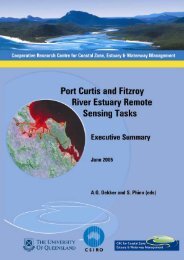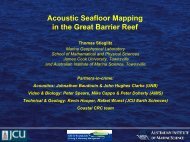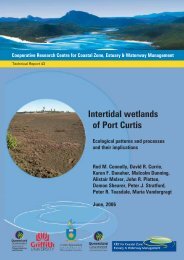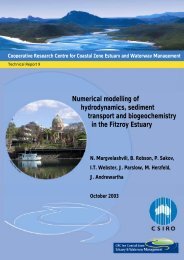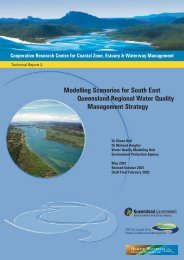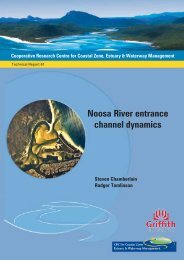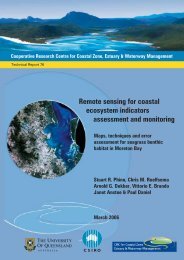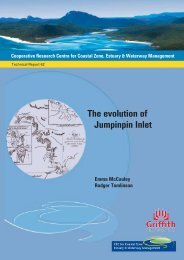Sediment accumulation and Holocene - OzCoasts
Sediment accumulation and Holocene - OzCoasts
Sediment accumulation and Holocene - OzCoasts
Create successful ePaper yourself
Turn your PDF publications into a flip-book with our unique Google optimized e-Paper software.
<strong>Sediment</strong> <strong>accumulation</strong> <strong>and</strong> <strong>Holocene</strong> evolution of the Fitzroy River lower floodplain<br />
The tides in Keppel Bay are semi-diurnal <strong>and</strong> feature a spring tidal range of 5 m<br />
(macrotidal), with a neap tidal range of approximately 2.5 m. Although the tidal<br />
limit of the Fitzroy Estuary once extended more than 100 km upstream from the<br />
mouth, the upper limit of the estuary is today defined by the barrage located at<br />
Rockhampton, 50 km inl<strong>and</strong>, which has modified the flushing characteristics of<br />
the river since its construction in 1970 (Connell et al., 1981; Hekel, 1980).<br />
Estuarine sedimentary environments<br />
A map of the broad-scale surficial sedimentary environments of the Fitzroy River<br />
estuary is presented in Figure 4 (Heap et al., 2001). The estuarine related<br />
habitats in the Fitzroy Estuary cover an area of 630 km 2 . This includes intertidal<br />
flats (13 km 2 ), mangroves (130 km 2 ), saltflats (275 km 2 ), s<strong>and</strong> banks (18 km 2 )<br />
<strong>and</strong> estuarine water area (or channel) (196 km 2 ). The majority of the low lying<br />
estuarine habitats occur to the south of the main river channel between the ‘Cut-<br />
Through’/loop <strong>and</strong> Port Alma <strong>and</strong> chiefly comprise salt flats. Mangrove<br />
vegetation is restricted to within 2 km of the channel networks which are complex<br />
in the south of the estuary (Ryan et al., 2004).<br />
The extent of these estuarine habitats has changed over time, due to both<br />
human <strong>and</strong> natural influences, such as climate <strong>and</strong> sea level changes. The<br />
historical coastline study (Duke et al., 2003) used aerial photographs from 1941<br />
to 1999 to assess these changes. They found that in the estuary mouth the area<br />
of saltpan/saltmarsh decreased over this time, whilst there was a net increase in<br />
mangroves related to areas of sediment deposition. This deposition was primarily<br />
in the lower reaches of the estuary. A significant change in hydrology has also<br />
occurred, related to the sediment deposition, probably caused by increased<br />
sediment loads from l<strong>and</strong> clearing in the catchment or changes in river flow.<br />
These changes in river flow may have been caused by dredging of the channels,<br />
the construction of training walls or the installation of the barrage at<br />
Rockhampton. Duke et al. (2003) also studied the changes on Balaclava Isl<strong>and</strong><br />
over the same time period (1941–1999) to assess changes related to climate<br />
<strong>and</strong> sea level, rather than anthropogenic influences. On Balaclava Isl<strong>and</strong> they<br />
observed a decrease in mangroves <strong>and</strong> an increase in saltpan <strong>and</strong> suggest this<br />
may be related to climate change, with a progressive decline in rainfall over the<br />
last 130 years (Duke et al., 2003).<br />
8


